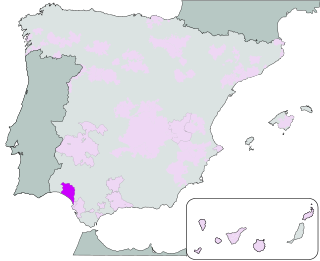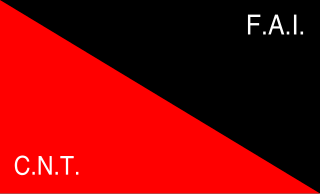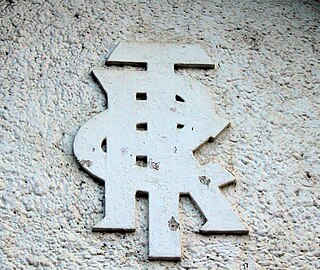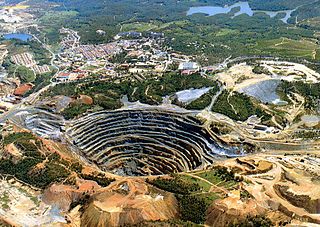
Huelva is a city in southwestern Spain, the capital of the province of Huelva in the autonomous community of Andalusia. It is between two short rias though has an outlying spur including nature reserve on the Gulf of Cádiz coast. The rias are of the Odiel and Tinto rivers and are good natural harbors. According to the 2010 census, the city had a population of 149,410. Huelva is home to Recreativo de Huelva, the oldest football club in Spain.

Evaristo Márquez Contreras was a Spanish sculptor.

The Diocese of Huelva is located in south-western Spain, and its borders coincide with those of the civil province of Huelva, part of the autonomous community of Andalusia. The diocese forms part of the Ecclesiastical Province of Seville, and is thus suffragan to the Archdiocese of Seville.

Condado de Huelva is a Spanish Denominación de Origen Protegida (DOP) for wines located in the south-east of the province of Huelva. The wines, known as the Wines of the Discovery of America, are produced there.

Corta Atalaya is the largest open-pit mine in Europe and was at one time the largest in the world. It is located within the city limits of Minas de Riotinto in the province of Huelva, autonomous community of Andalusia, Spain. It is roughly elliptical in shape, 1,200 metres (3,900 ft) long, 900 metres (3,000 ft) wide, and 350 metres (1,150 ft) deep. It was one of the most ambitious projects of the Rio Tinto Group. At its peak it employed 2,000 workers mining copper; it was actively mined until 1992. Since at least 1994 it has been flooded up to the 16th ring.

The Romería de El Rocío is a procession/pilgrimage on the second day of Pentecost to the Hermitage of El Rocío in the countryside of Almonte, Province of Huelva, Andalucia, Spain, in honor of the Virgin of El Rocío. In recent years the Romería has brought together roughly a million pilgrims each year.

Rociana del Condado is a town located in the province of Huelva, Andalusia, Spain.

The Spanish coup of July 1936 was a nationalist and military uprising that was designed to overthrow the Spanish Second Republic but precipitated the Spanish Civil War; Nationalists fought against Republicans for control of Spain. The coup itself was organized for 18 July 1936, although it started the previous day in Spanish Morocco, and would result in a split of the Spanish military and territorial control, rather than a prompt transfer of power. Although drawn out, the resulting war would ultimately lead to one of its leaders, Francisco Franco, becoming ruler of Spain as a dictator.

The July 1936 military uprising in Seville was a military uprising in Seville, Spain on 18 July 1936, which contributed to the start of the Spanish Civil War. The 17–18 July coup failed in the Andalusian cities of Malaga, Jaen and Huelva, but succeeded in Cordoba, Granada, Cadiz and in the capital city, Seville. The city's garrison, led by Queipo de Llano, occupied the city and carried out a bloody repression. In August 1936, the Nationalists started their advance towards Madrid from Seville.
The Córdoba offensive was a failed Republican offensive against the Nationalist held city of Cordoba. It took place from 19 to 22 August 1936 during the Spanish Civil War.
The siege of Santuario de Nuestra Señora de la Cabeza took place from 14 September 1936 to 1 May 1937 in Andújar, Jaén, during the Spanish Civil War. The Republican army surrounded around 1,200 rebel civil guards and falangists who supported the Nationalists and forced them to surrender after a protracted offensive.

Gonzalo Queipo de Llano y Sierra was a Spanish military leader who rose to prominence during the July 1936 coup and then the Spanish Civil War and the White Terror.
Carmen Luna Alcázar was a Spanish feminist and anarchist executed by Francoist forces. From Utrera in the region of Andalusia, Spain, she worked as a fruit and vegetable vendor.

The confederal militias were a movement of people's militia organized during the Spanish civil war by the dominant organizations of anarchism in Spain: the National Confederation of Labor (CNT) and the Iberian Anarchist Federation (FAI).
The Asturian Miners Column was a popular militia that fought for the Republicans during the Spanish Civil War in the Province of León. On the night of 18 July 1936, a special train full of miners left Asturias for Madrid, in order to defend the constitutional order. The train, after passing through León, returned to Asturias from Benavente on 21 July. A part of the mining column participated in the defense of Ponferrada.
José Fernández de Villa-Abrille y Calivara was a Spanish general in charge of the Seville garrison who capitulated to rebel forces at the beginning of the Spanish Civil War.
Manuel Díaz Criado was a Spanish infantry officer. With a reputation as a brutal sadist, he was during the Spanish Civil War responsible for the arrest, sexual abuse, torture and execution of thousands of people in the regions of Andalucia and Extremadura who opposed the Nationalist military uprising. The crimes frequently extended to the relatives and the associates of those targeted.
José Cuesta Monereo was a senior Spanish army officer, regarded as the planner of the Spanish coup of July 1936 in Seville at the beginning of the Spanish Civil War, and thereafter other areas, initially under the command of general Gonzalo Queipo de Llano. The plans resulted in the abuse, torture and murder of thousands of local people.

The Rio Tinto Company Limited (RTC) was one of the founding companies of the Rio Tinto Group conglomerate, which was responsible of the exploitation of the Riotinto-Nerva mining basin in Minas de Riotinto between 1873 and 1954.

The Riotinto-Nerva mining basin is a Spanish mining area located in the northeast of the province of Huelva (Andalusia), which has its main population centers in the municipalities of El Campillo, Minas de Riotinto and Nerva, in the region of the Cuenca Minera. It is also part of the Iberian Pyrite Belt.














